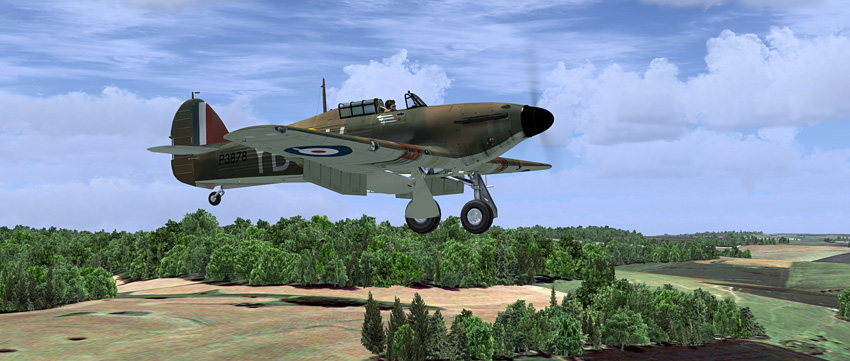Jump to: Hawker Hurricane | Messerschmitt Bf-109E | Supermarine Spitfire | Verdict
| Background The Battle of Britain is one of the first and only battles to be fought and won completely from the air. According to RAF sources, the Battle of Britain was fought between the 10th July and 31st October 1940. German historians dated this between Mid-August 1940 to May 1941, when German forces withdrew their bomber units in preparation for the attack on the USSR. After conquering France without too much resistance, Hitler turned his attentions to Britain. Knowing that an invasion by sea was near impossible due to the Royal Navy's fleet of destroyers and Battleships defending the islands, he realised Germany's only hope was to gain air superiority in order to bomb the defences, early warning radar and naval bases that serviced the ships. By the beginning of July 1940, the RAF had 640 fighters, but the Luftwaffe had over 2600 fighters and bombers. This huge force enabled Germany to maintain relentless day and night raids on airfields in the south and nearly forced the RAF to retreat north, but they bravely hung on. On the 20th August 1940, in the House of Commons, Churchill made one of his most poignant speeches where he said: "The gratitude of every home… goes out to the British airmen who, undaunted by odds, unwearied in their constant challenge and mortal danger, are turning the tide of the world war by their prowess and by their devotion. Never in the field of human conflict was so much owed by so many to so few". One of the most important days of the battle was the 7th September 1940. After pounding the RAF 11th group's airfields, Germany decided they had suffered enough damage to render them useless in the short term so changed their focus to launch an all out attack on London, the political heart of Britain. This change of tactics proved to be its downfall, allowing the RAF to cover and repair their airfields and a week later, on the 15th of September, the Luftwaffe suffered its biggest loss of aircraft claimed to be 185 by the the British propaganda machine but was in fact 60. It became obvious to the Germans that they could not win the battle in the air. Attacks carried on for several weeks but they eventually petered out. This historic defeat is celebrated on the 15th of September in Britain as the Battle of Britain Day, Germany’s first military failure of the war. |
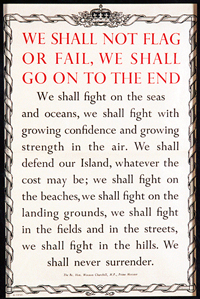 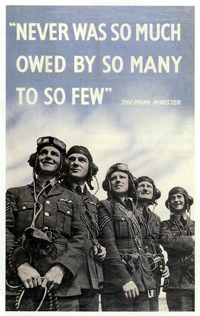
|
The package
What I am reviewing today is the complete DVD Battle of Britain
70th Anniversary pack. The package features 3 of the most famous
fighters of the war; the Hurricane, Spitfire and Messerschmitt
Bf-109E. The DVD version comes supplied with a superb 100 page
manual, product presentation is something that Just Flight do so
well. The manual is packed with interesting reading about the
BoB as well as its aircraft along with installation and set up
notes that will allow you to get the best from each model.
The aircraft modelling and design was developed by Aeroplane
Heaven who have a long lineage in producing top quality
historical aircraft. These aircraft however are only available
exclusively from Just Flight and are part of a recent developing
and publishing agreement between the two companies with many
more to come.
This 70th Anniversary package is also available as a download
for the same price of £39.99 or, if you only want one aircraft,
they are available separately for £19.99 each so if you want at
least two of the aircraft the anniversary pack gives you the
third one free!
 |
Installation Pop the DVD in and go! A quick and painless operation, it will search your registry for the location of FSX but if it cannot find it will allow you to manually set the installation folder. You can choose which aircraft to install, don't forget that choosing all three will cost you up to 1.1Gb of space. For downloads, the installation is just as simple. After purchase, you download your file via the direct link on the confirmation screen (also sent to you in an e-mail). Then, you run the install program and enter, when prompted, your Just Flight e-mail and account password. The product unlocks and away you go! Documentation As mentioned earlier, one thing Just Flight does well is to document their products and this product is no different. In fact they have taken extra care with this one so it looks and feels like a commemorative version. The "Pilots Notes" as they call it, are full of interesting facts about the BoB as well has aircraft specifications and handy hints on getting each aircraft in the air and keeping them there! |
Having said this, I found the manual to too focussed on the aircraft and lacking detailed information on the best setup of the flight sim. Individual aircraft setup information was good, with instructions of how to start from cold and dark and key assignments for the guns etc. What is just as important in my view are the realism settings, how else are we going to re-live these courageous flights as accurately as possible? The flight model should be set to realistic as I have detailed below:
|
FSX Aircraft/Realism Settings: General Realism Slider: MAXIMUM P-factor Slider: MAXIMUM Torque Slider: MAXIMUM Gyro Slider: LOW Crash Tolerance Slider: MINIMUM Enable Gyro Drift: TICKED Display Indicated Airspeed: CHECKED Ignore Crashes and Damage: CHECKED Enable Automixture: OFF Engine Stress Damages Engine: OFF G effects: ON Autorudder: OFF – Essential for spinning! |
 |
Lets have a look at each of the aircraft in
the box.
Hurricane Mk1
The history of the Hurricane harks back to 1933 when Sydney Camm
discussed with the Air Ministry the possibilities of producing a
monoplane fighter. The first prototype Hurricane flew on
November 6th 1935. It had been based on the design of the Fury
bi-plane built by Hawker and was powered by a Rolls-Royce Merlin
engine. On October 12th, 1937, the first flight of a production
Hurricane took place. By the end of 1938, 200 Hurricanes had
been delivered to the RAF’s Fighter Command. By September 1939,
19 RAF squadrons had been equipped with Hurricanes.
The original Hurricane's airframe was made of braced metal
tubing, mostly covered by fabric (including the wings). The
engine cowl and the front part of the fuselage had a metal skin.
After September 1939, all Hurricanes were delivered with wings
of stressed skin, all metal construction, but the fuselage
behind the trailing edge of the wings remained fabric covered.

The Hurricane was the first RAF plane to
destroy a Luftwaffe plane in October 1939 when Pilot Officer
Mould shot down a Dornier Do-17 over France. But it was in the
Battle of Britain that the Hurricane made its mark. The battle
is frequently romantically associated with the Spitfire, but the
Hurricane played a major role. By August 1940, the RAF could
call on 32 squadrons of Hurricanes and 19 of Spitfires,
therefore, the Hurricane was the dominant British plane in the
battle.
The Hurricane was the RAF's first 300mph fighter, though slower
than the Spitfire, the Hurricane developed a reputation as a
plane that could take more than a few hits. It was at a
disadvantage at higher altitudes but with its ease of
maintenance and good-natured flying characteristics, the
Hurricane remained in use where reliability, easy handling and a
stable gun platform were more important than performance,
typically in roles like ground attack.
One of the design requirements of the original specification was
that the Hurricane, as well as the Spitfire, was also to be used
as a night-fighter. The Hurricane proved to be a relatively
simple aircraft to fly at night and was to be instrumental in
shooting down several German aircraft during the nocturnal
hours.
The virtual Hurricane
Models included:
| Prototype K5083 - First flown on
6th November, 1935 First production Hurricane 2 Blade (Battle of France era) JX-H L1842 - RAF's first kill over France FT-N L1723 - RAF's first kill over British soil JX-G - Squadron code painted over and gas detector on wing 111 L1584 - Experimental livery Royal Yugoslav AF - 1938 model |
Standard RAF Hurricane Mk1 3
Blade (Battle of Britain era) GZ-L P2921 - Flown by Flt. Lt. Pete Brothers UP-W R4118 - Still flies today KW-Z L1592 - London Science Museum YB-W P3878 - Sky coloured spinner LE-D V7467 - Flown by the legendary Sq. Ldr. Douglas Bader |

Interior
There are 2 different types of interior which loosely equate to
the 2 prop and 3 prop MK1s. The 2 prop version has the old ring
and bead gun sight and the latter the reflector type that you
see featured in the pictures below.
The interior looked suitably worn in most areas like the hand
grips and the seat, however, there were some very clean textures
too, like the foot straps on the pedals which I would have
expected would have seen plenty of action. The overall effect
was very good, plenty of cables, pipes and levers which on
operation moved very smoothly.
There many click spots, most of them have tool tips even if
their operation had no affect on the sim. The manual lists them
in good detail, including the non-operational ones. One of the
most interesting features is the modelling of the gear/flaps
lever. This is is very similar in looks to an automotive gearbox
with one lever moving through a letter H pattern via left and
right clicks of the mouse. This is superbly modelled and quirky
in use!
 |
 |
The gauges were very clear and easy to read
with the oil and fuel temps and pressures being highlighted
using red and orange bezels. One very notable feature is how
smooth and responsive they are in operation. There is a popup 2d
panel available for those not so used to the VC, the panel shows
the main 6 instruments along with sim icons for the map,
kneeboard and ATC window.
The radio popup looked good but there is no instruction on its
use you have to figure it out for yourself, admittedly it wasn't
that difficult. The illuminated aiming reticle in the 3 blade
version was finely detailed right down the the 3 spare lamps ( I
guess these used to blow regularly).
Finally, the animation of the canopy was smooth as was the
slider for the push out window and the operation of the door.
Exterior
The external textures are excellent with full self-shadowing and
bump-mapping, to the rear of the fuselage you can really get the
effect of fabric stretched over steel tube stringers.
The paint was well treated with oil, scuffs, wear and tear and
smoke and burn marks from the cannons. The liveries are true to
their real world counterpart right down to the silver white and
grey underside of L1584 and the squadron codes being painted
over on J-XG, a nice touch or realism there.
When on the ground, a hidden click spot in the cockpit will
enable a nicely detailed engine starter battery trolley which
connects to the aircraft in a realistic way.
 |
 |
Animations
There are quite a few animations with this model, the pilots
head constantly scans the instruments and horizon, he even
blinks. Above 8,000 feet, the oxygen mask will be automatically
clipped into place.
When the canopy opens a stirrup appears to help the pilot up
onto the wing along with an accompanying hand grab. Further
presses of the Shift+E key plus 2,3 or 4 will reveal the mighty
Merlin engine along with the fuel tank, the final sequence
uncovers gun hatches on the wing to expose the browning machine
guns and bullets and an inspection panel on starboard side to
reveal more cockpit detail.
A section of the canopy glass can be removed to enable pressure
equalisation and the canopy can be jettisoned via a lever to the
left of the seat. These features aren't so much animated the
textures more disappear from sight, the aircraft has to be reset
to get these back.

On starting the engine, changing the prop pitch is animated as
well of plumes of black and white smoke from the exhausts, these
soon disappear aft the smoke has blown through the pipes.
All control surface are animated as expected, again very
smoothly. Undercarriage animation is excellent with the
port wheel generally parking before the starboard, if you look
in the wheel bays you will see moving parts hauling the gear in.
Finally in this section, there is animated cannon fire with
flame flashes and animations of spent bullets falling away from
the aircraft, this is a nice feature and very fitting for this
aircraft.
Sound
The sound of the Merlin makes your hair bristle!
A fine roar on start-up has to be experienced at least once from
the outside as you wont get the full impact from the pit. Also
make sure you use the fly by camera a couple of times to
experience the changing engine note and when flying away from
you the sound flutters a bit like it does in real life.
The cannon sound is ok, it sounds like someone banging drums in
a hallway, very resonant and bass-y but effective.
Flying the Hurricane
I am no Hurricane pilot so I can only judge the flight model by
what I expect it to do!
As mentioned earlier, the only way to enjoy these warbirds is to
set the realism high. Than manual takes you through the
pre-start and starting procedures so follow them to the letter,
auto-starting is not an option! (Ok it is, but are you man or
mouse?!)
Before the take off roll the rudder trim wheel should be set to
full right. Get used to using this as without it you are going
to take a sharp left off the runway before take off! This is the
P-Factor kicking in. The torque of the engine is such that you
will still need some right rudder and aileron to keep her
straight and level.

Also modelled, as I found out to my embarrassment, is the "nose
over" as I had forgotten to release the park breaks, just as
well this wasn't a real aircraft!
Once rolling, as with all tail-draggers forward pressure on the
stick will bring the tail up and after a small input of
backpressure she will leave the ground. It's really not
difficult to get her airborne, after a few seconds when you are
up to around 100ft retract the gear and close the canopy.
Now you can let her gain some decent speed and altitude because
you literally want to take her for a spin, don't you?
Remembering that altitude is king make sure you take time to get
her above 10,000. At 8,000 the oxygen mask will latch on and you
can turn the oxygen on (the switch and gauges are modelled).
Leaning the engine gives a better and stronger performance at
this height and the controls should remain responsive.
Rolling, looping and spinning is also explained in the manual
along with the stall and maximum speeds. I tried most of these
procedures with reasonable success and it was fun to do. Now,
in the real world, some of the stresses the body goes through
would limit some of your actions.
You never really get a sense that the Hurricane is going to let
you down, she feels solid and reliable so long as you have the
height. (Sadly not a luxury Brian Brown had at the tragic
airshow crash at Shoreham in 2007) so be wary.
I really cannot fault the flying characteristics of this model,
she has become a favourite of mine and never far away from the
scramble!
Messerschmitt
Bf-109E
The first Bf-109 prototype flew in September 1935, powered by a
British, liquid-cooled, Rolls-Royce Kestrel VI twelve-cylinder
upright-vee engine. This was the engine choice of other German
aircraft manufacturers too producing prototypes, vying in a competition to
supply a new fighter to the Luftwaffe. The first production
model, the Bf-109B-1, was delivered in February 1937. The Bf-109
E, the variant which saw action during the Battle of Britain,
entered into service early in 1939.
The Bf-109 E (Emil) was fitted with the fuel injected Daimler
Benz 601A-1 engine, a three-bladed variable pitch propeller,
under-wing radiators, and four MG-17 7.9 millimetre guns, with
two in the cowling and one under each wing. The wing guns were
replaced with MG-FF/M 20mm cannons which resulted in the fitting
of a blister in the lower wings An experimental MG-17 machine
gun was situated between the engine cylinders and fired through
the propeller hub, although no longer fitted, the spinner
modification can still be seen.
Performance wise, the Bf-109E4 (featured in this package) had a
ceiling of 34,000ft with a max speed at altitude of 300 KT and
only a 355Nm range. The latter proved to be a liability, since
it could not stay over the battle area for very long before
having to return home.

A notable feature was the landing gear which had a narrow track
and was hinged in the fuselage to retract into the wings. The
narrow gear not only made the aircraft unstable on the ground
but were also weak and prone to collapse. 10% of BF109s were
written off in ground accidents, the landing gear problems would
be a long-standing difficulty for the aircraft.
The earlier campaign in France had suggested the need to the
Luftwaffe for a fighter-bomber. A number of Bf-109s were
experimentally fitted with centreline bomb racks. Such racks
would be fitted to sub-variants of the aircraft through the rest
of its evolution from the 109-E4 onwards. The racks allowed the
carriage of a 250 kilogram (550 pound) bomb, four 50 kilogram
(110 pound) bombs, or a 300 litre (80 US gallon) drop tank.
These bomber sub variants were not fitted with a bombsight as
such, but the standard Revi gun sight could be used in dive
attacks with some accuracy and a line was painted on the
windscreen to help the pilot with his aiming.
The Luftwaffe lost 610 Bf-109s in the Battle of Britain, more
than they had bargained for, post-war the 109 was built in
Czechoslovakia, as the Avia S-99 and S-199 and in Spain as the
Hispano Aviación Ha 1109 and 1112 still seen at airshows to this
day.
Alan Deere, who served with No. 54 Squadron during the Battle of
Britain, summed the Bf-109 up:
"Undoubtedly, the 109 in the hands of a good pilot was a
tough nut to crack. Initially, it was faster in the dive, but
slower in the climb; the Spitfire could out-turn, but it was at
a disadvantage in manoeuvres that entailed negative G forces.
Overall there was little to choose between the two fighters".
The virtual Me 109E
Models/liveries Included:
|
Bf-109E Battle of Britain version StabII/JG54 - Yellow nose II/JG53 "Red band" Japanese Tester Escadrila 58 - Donald Duck 3.J/88, Condor Legion - Spanish Russian - Green, Red star Captured French - 'White' 6 |
3.JG52 - "Horrido"
emblem Stab III/JG54 Light mottle Stab 9/JG54 Yellow 13 Stab/JG2 heavily stippled mottle Stab/JG26 - Yellow nose Stab/JG2 - As flown by Pilot "ace" Major Helmut Wick Stab/JG3 - Based in France, 1940 |
Bf-109E-4
Tropical Model 1/Jg27 - Tropical camouflage Staffel9 Gruppe I JG27 Staffel9 Gruppe 2 JG27 |

Interior
The cockpit of the 109 was notorious for its enclosed and
cramped layout and you really get a feel for it here. This
cockpit looked a little more lived in than the Hurricane which
for me is a good point adding to the realism. To the left,
chains, levers and push-rods give a good mechanical feel.
As with a lot of modern German design, it has sparse, functional
controls, the yellow fuel related items stood out well against
the dull interior as did the red "beware" controls. The gauges
are more visible than its counterparts and easy to understand
and read. There didn't appear to be as many clickable switches
but then I don't think there were in the real deal. Now this is
a place where the tool-tips come into their own. For a non
German speaker you will be thanking Aeroplane Heaven for all the
time taken to include as many as possible.
 |
 |
Behind your head you have some decent armour plating but the down side to this is it obscures your rear view, a point often made by the pilots. The canopy is hinged on the right and has a couple of sliding windows either side which can be operated with your mouse. The canopy itself can be jettisoned but like the Hurricane it just vanishes.
| There is a flight sim related
panel to the right of the dashboard which controls sim
functions such as map, kneeboard, radio, ATC and loadout.
With loadout you can configure the ordnance, whether you
have the large bomb, fuel tank or the 4 x 50Kg bombs. I
liked the simplicity of this feature and the way the
panel blends into its surroundings, as though it is
meant to be there! The radio pop up feature is very similar to the Hurricane being a 2d panel and if I didn't know better I would say the are the same. The real FUG V11 radio panel can be seen on the dash and is clickable but for visual effect only. The Revi C12/D 3d reflector gun sight is nicely modelled with an offset rear sight to the right for the more dominant eye, You can see in the detail that this could be moved for left eye operation as well. (Although not modelled). It's all there if you look for it! I found I had to raise my viewpoint quite a bit to get the best all-round visibility and I had to use the side windows a lot to get my bearings. I can only imagine how awkward this was in the real 109. |
 |
With such a wide choice of liveries there should be a design you like. They are all good and some of the detailing and wear and tear is truly excellent.
Walking around the aircraft you will notice the wings are slender and fairly square-cut at the tips, it also has leading edge slats which deploy automatically. Mounted in the wings are the cannons and twin radiators and a pitot-static tubes.
Moving to the rear there is an animated opening compartment in the fuselage which uncovers Telefunken radio equipment, again, with good detailing. On to the tail the 109 has a high mounted horizontal stab with struts and unusually, a rudder with no trim which severely limits a pilot's ability to turn left when diving. I look forward to trying that, not! From the tail to the cockpit runs the aerial and this moves around in flight as though it is being buffeted by the wind, another nice touch.
The canopy pivots around a hinge on the starboard side and is smoothly animated albeit angular in design. This reveals the pilot, which from an outside view, can be seen scanning the skies for the enemy. Other animated features include the engine cowling being removed to expose a huge V12 engine and the machine guns high up and to the rear. The machine guns and cannons fire in the same manner as the Hurricane with the same sound effects.
 |
 |
Sound
I am not sure of the source of the engine sound but it did sound like a powerful V12. After many fly-bys I did start to detect a certain note to the engine but it definitely isn't as distinctive as the Merlin.
I liked the engine start sound, on the press of the starter she splutters into life with a puff of smoke and runs a bit rough for a few seconds before settling down.
The animation and sound of the guns is the same as the other two aircraft, maybe a better sample could have been used but that's only a minor point, essentially it's only eye candy.
The sound in the cockpit was good, when the engine is silent you can hear the clock in the cockpit ticking and you can clearly hear the feedback from the engine when using increasing the revs.
Flying the Emil
Right from the word go, you know you are flying an aircraft built to a different philosophy than the British aircraft. You can sense innovation, there is no mixture lever, it's automatic, so you must ensure "Enable automixture" is checked in the realism settings otherwise you will not experience the best performance from the aircraft. There are leading edge slats which operate automatically but I couldn't work out the criteria for their operation, they seemed to deploy on landing with the flaps and sometimes in the middle of aerobatic manoeuvres, fascinating to watch though. See below for example.

I thought takeoff was going to be difficult as you have no
rudder trim available but actually I found little or no opposite
forces where needed, properly trimmed, she just floated into the
air after a very short takeoff run. The gear pretty much
retracts in sync with the port wheel always slightly ahead of
the other.
I thought she was a bit sluggish in the turn and this is how it
should be, one of the benefits of the other two aircraft was the
manoeuvrability when turning. She has a good rate of climb and
is in the clouds in a couple of minutes. Diving is an
uncomplicated affair and she readily pulled up without fuss.
I found rolling and spinning to be pretty unexciting and slow in
the responsive. She drops gracefully into a stall with no
wing-over you have to push her hard to get her to twist and
turn. Definitely not an aerobatic aircraft!
With all this said, I really enjoyed flying her, much more than
I thought I would. I would say the flight characteristics are
pretty accurate to descriptions I've read and she is refreshing
and uncomplicated to fly, a little bit like driving an automatic
car!

Vickers Supermarine Spitfire
Does this aircraft need an introduction? Possibly not, it's the
most famous aircraft of the 20th Century, an iconic fighter
loved the world over for her beautiful lines, manoeuvrability
and fire power.
At 4.35pm on the 5th March 1936, Vickers Supermarine chief test
pilot Capt. J. 'Mutt Summers' raised the specification F.37/34
prototype 300 Spitfire (Serial K5054) into the air at Eastleigh
Aerodrome. (Now Southampton International Airport EGHI,)
The first flight lasted just 8 minutes, it took off 35 degrees
across wind, this was because experience with the racing
seaplanes had revealed a strong tendency to swing to port due to
the high torque.
 K5054 ready to go |
Summers found that although there was
indeed a tendency to swing, it was easily checked by the
application of the opposite rudder. The aircraft seemed
to drift into the air and the maiden flight, which was
made with the undercarriage locked down, was effortless.
Upon landing 'Mutt' is famously quoted as saying "I
don't want anything touched" In fact the only thing
that was touched was the propeller. For the maiden flight K5054 had been fitted with a fine pitch propeller to give the pilot more rpm therefore more power on take off. This prop was replaced by a normal-pitch one for the second and subsequent flights. Over the next three days a further three flights took place, all piloted by Mutt; lasting 23 minutes, 31 minutes and 50 minutes during which time he flight tested the aircraft with a variety of stalls and steep turns to fully explore the flight characteristics of this unique aircraft. The next few months saw further trials carried out with no major problems and K5054 was delivered to the Aeroplane and Armament Experimental Establishment at Martlesham Heath for official trials on 26 May 1936. The Air Ministry were so impressed with this new fighter aircraft that prior to the full test programme being completed they issued a contract for 310 Spitfires on 3 June 1936 to the value of £1.25million. The prototype Spitfire achieved a maximum speed of 349mph (increased to 364mph in the first production Mk I's), had excellent manoeuvrability, rate of climb and turning circle. Pilots were to describe the ease of its control in the air as almost flying itself. On 15th May 1938 Jeffrey Quill, the then chief test pilot, flew the first production Spitfire, K9787, from Eastleigh and then, on 4th August 1938, he delivered the first RAF Spitfire, K9789, to No.19 Fighter Squadron at Duxford. By 1945 the aircraft had significantly increased its fire power, nearly doubled its rate of climb and achieved a speed of 450mph, almost exactly 100mph faster than the K5054 prototype. These achievements are testament to RJ Mitchell, and his team's brilliant original design. |
|
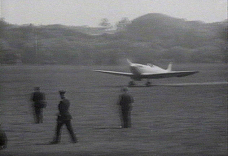 She drifts into the air |
||
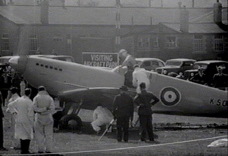 Summers exits the aircraft |
From 1938 until manufacture ceased in 1947, over 22000 Spitfires were built. Unfortunately, due to his untimely death on 11th June 1937, R. J. Mitchell never saw his greatest design legacy into production.
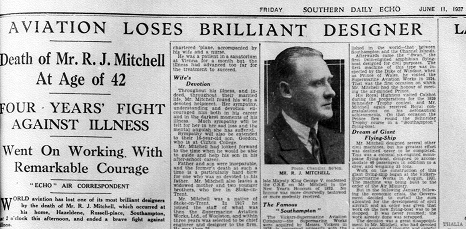
The Spitfire was developed into 24 different marks and in
addition to being an RAF fighter, it fulfilled roles as a
folding-wing aircraft carrier plane and photographic
reconnaissance aircraft.
As a footnote, on 4th September 1939, the day after war broke
out, the original prototype crash landed due to a misjudgement
on the part of the
pilot, Flt Lt 'Spinner' White. Sadly he was killed and K5054
never flew again.
The Virtual Supermarine Spitfire
Models included:
| Prototype K5054 - First flown on first flew on March 5, 1936/ K5054 - As seen at Hendon Air Pageant, Wheel spats Mk1 Early 2 blade K9795 - First production Spitfire to be delivered to the RAF for operational use K9854 - QV-W flown by Flt.Lt. Wilfred Clouston K9906 - FZ-L flown by Flt. Lt. Robert 'Bob' Stanford Tuck ZP-A Flown by Flt.Lt. Adolf "Sailor" Malan |
Mk1 A P9546 - QV-H flown by George 'Grumpy' Unwin. P9386 - QV-K flown by Squadron Leader Brian Lane P9398 - KL-B flown by Squadron Leader Al Deere P9323 - ZD-F flown from Hornchurch July/August 1940 L1043 - DW-O flown from Biggin Hill July 1940 R6775 - YT-J flown from Hornchurch July 1940. |

Interior
When climbing into the cockpit of the prototype Spitfire the
first thing you come across is a message from Mutt Summers
himself with a hand scribbled not "Touch NOTHING!" on the seat.
A real cute touch, the cockpit is fully functional but we will
be concentrating on the Mk1 cockpit for this review.
The Spitfire, initially, had a better protected cockpit than the
109 with bulletproof windscreen and an armoured plate behind the
pilot's seat. The Spitfire had an advantage with better rear
view and you can see that clearly here, the cockpit feels bright
and airy. The canopy slides open by a click on the pull strap
and also has a jettison handle just below the rear view mirror.
In look and feel you will see similar gauges as used in the
Hurricane but that was probably how it was in real life so saved
a bit of extra work in the production of the real aircraft
aircraft and this model. The main gauges are bright and clear
and smooth in operation, many of them have War Dept stamps and
serial numbers quite clearly modelled. There are plenty of
controls, knobs and switches to discover, fuel and oil pressure
gauges have the familiar red and yellow bezels and to the right
are temperature and boost gauges.
 |
 |
One of my pet hates is unlabelled switches where the cursor
turns to a hand when you hover over them. I found a couple here,
you will find descriptions in the manual so that is acceptable
but should have been picked up in beta testing.
There are some super animations in the cockpit such as the map
box and radio panel. The later cockpits have noticeably
different gun sites with the early models having ring and bead
as opposed to reflector types.
A 2d panel is available with the main six and sits nicely at the
bottom of the screen, I didn't use this panel but it looked
functional.
The interior detail is certainly a credit to the developers and
really adds kudos to this product.
Exterior and animations
Like the previous two aircraft,
The quality of the external textures is superb, there are 12
different liveries over the 3 models. On close inspection you
will see some bump mapping and shine. The markings, roundels and
paint wear all add to the authenticity.
From the outside, the cockpit drop-down door and canopy slide
(Shift+E+3 & E) are very smooth and reveal a very detailed
animated pilot. Shift+E+2 will hide the pilot and open a flap on
the rear port side, then the radio set slides out for
inspection. The final exit command Shift+E+4 reveals the Merlin
engine and opens the engine starting electrical socket door.
 |
 |
The ground cart can be called from a hotspot in the cockpit,
this dutifully appears and plugs into the aircraft. When
starting, the sound of the cranking Merlin is great. When
she fires into life a puff of oily smoke is emitted.
All these animations worked perfectly and as realistically as I
would have expected and certainly pass the quality test with
flying colours.
Sound
The Spitfire uses the same sound set as the Hurricane to the
distinctive Merlin sound can be enjoyed in much the same way. My
advice is turn up the volume as much as you dare and just enjoy
that wonderful sound!
Flying the Spitfire
Ok, we need to make sure the automixture has been turned off
after flying the 109 and the realism set to max.
The Manual gives some good tips on and flying the Spitfire. If
like me you plan to fly a realistic flight model then be sure to
follow the procedures in the manual.
After starting make sure you give her time to warm up, this will
give you the opportunity to read up on the pre-flight checks you
will need to make. Get the trim set correctly, particularly
full right rudder trim, no elevator trim should be required.

On the takeoff roll make sure to are ready to give plenty of
right rudder on demand, also if she swerves left the right wing
may rise so some right aileron may be required too. As the tail
lifts she will usually just drift upwards, if you were to push
the nose forward to raise the tail you can gain a bit more speed
but is a riskier operation!
Raise the gear as soon as you can and note the mechanical gear
up indicators disappear into the top of the wing. As you climb
to a safe altitude you can set the prop revs back and take a
touch off the mixture. Now get her straight and level and trim
her out.
Once you start to test her out you will notice how responsive
the controls are. Her climb rate is excellent and you can take
her over a loop without fuss. Once at high altitude lean the
engine more to get better performance, this can definitely be
experienced in this model.
Pulling tight turns are fun especially when you know the 109
could never match this. I found I could really toss this
aircraft around in the sky and she would be very forgiving. If
you really want to let off steam give the cannons a go and watch
the muzzle flash and spent bullets trail away from the plane.
Excellent.

I could imagine a lot of users would want to use mulitplay
in this aircraft forming squadrons and performing dog-fight type
manoeuvres!
Performance(All)
As all three aircraft are modelled in a very similar fashion, it
is safe to say that if you get the display settings for one set
up correctly, they will all run well. Although there are quite
a few systems modelled, I didn’t feel my machine was under
stress, even in sharp turns where you are most likely to get
issues. This is a notable point as I dare you not to fly the
Spitfire without wanting to loop or spin!
When reviewing sim performance, it is only fair to run with
default scenery (Except for screenshots). I am fortunate that
my review machine is of a fairly high specification (See below)
therefore, unchecked, I was enjoying FPS in the high 60’s.
However, this in itself can cause stuttering issues, so I use a
3rd party program called FPS limiter and check the frames at 25
FPS, this ensures those smooth transitions.

![]() Verdict
Verdict
Individually, each aircraft appeared to be true in looks and
accurate in performance to its real world counterpart. They all
have their individual flying characteristics, some good, some
bad and this is a great way to find out for yourself. There are
plenty of models and variants to keep you busy for a long time.
The DVD presentation pack at £39.99 is excellent value for money
with its superb souvenir type pilots notes handbook, a must have
collectors item for anyone interested in warbirds and the Battle
of Britain as a whole.
I thought these were truly stunning models, now these legends
live on...
My score? for each aircraft a 9.5/10. For the package 10/10 and the coveted Mutley's Hangar award for Excellence! Well done to Alex Ford and the team for an excellent and very well presented product.
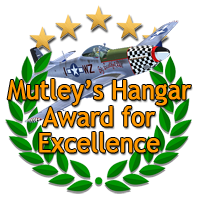
![]()
/Joe Lawford
Review machine Spec: Core i7 Extreme 965 @ 3.6 Ghz |
12Gb Tri-Channel Corsair DDR3 Ram |GX260 Graphics |Windows 7
64bit Pro
 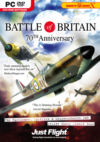 |
System Requirements
|
|
|
|

